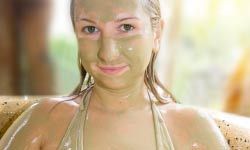 “iStockphoto.com/Olga Khoroshunova
“iStockphoto.com/Olga Khoroshunova
If Dead Sea mud was good enough for Cleopatra, then it’s worth a try, right? Since ancient times, people, including the powerful female pharaoh, have soaked away their ailments in the healing waters of the Dead Sea, a giant salt lake flanked by Israel, Jordan and the West Bank [source: Pfeiffer]. The mud is thought to be so restorative that hundreds of thousands of tourists visit the Dead Sea each year [source: McElroy], while stores around the world peddle skin products made from its mud and salt crystals.
The Dead Sea’s healing power is more than just myth. The lake boasts high concentrations of magnesium, sodium, phosphates, bromides and other minerals thought to improve skin conditions as well as certain heart and lung conditions [source: Lev-Ram]. Studies have suggested that Dead Sea minerals can improve the quality of life for psoriasis patients [source: Dead Sea Research Center], hydrate the skin [source: Proksch] and reduce roughness and inflammation [source: Long].
Not only does Dead Sea mud contain these beneficial minerals, but it’s also been shown to kill acne-causing bacteria [source: Ma’or]. That’s why cosmetic companies like Ahava — founded after a local spa worker noticed tourists scooping up Dead Sea mud to bring home — use it in masks, exfoliators, lotions and soaps [source: Lev-Ram]. A popular treatment at high-end spas in Israel and beyond, body wraps made from Dead Sea mud are thought to nourish and detoxify the skin, and there are even claims that they erase stretch marks and cellulite.
Cosmetics containing Dead Sea mud can be pricey and loaded with other ingredients, but you can buy packages of the pure product at many health food stores. Skin-care expert Julie Gabriel, author of the book Green Beauty Recipes, recommends making your own face mask at home by combining Dead Sea mud with an equal part of clay, then adding some olive oil.
For maximum benefits, however, you might consider going straight to the source. Experts believe it’s not just the mineral composition of the Dead Sea that clears visitors’ skin. Sitting at the lowest point on Earth, the Dead Sea is covered by a thick haze that filters out damaging ultraviolet rays but allows therapeutic light to shine down [source: Orenstein]. The filtered sunlight has proven effective in the treatment of psoriasis — and it also means you’ll be less likely to burn.
To find out more about how the Dead Sea can help your skin, check out the links on the next page.
Lots More Information
Related Articles
- Is the Dead Sea really dead?
More Great Links
- The Dead Sea Research Center
- Sea Salt Benefits
- Israel Ministry of Tourism
Sources
- Dead Sea Research Center. (July 2, 2013) http://www.deadsea-health.org/new_html/studies_main.html
- Gabriel, Julie. Personal correspondence. July 1, 2013.
- Lev-Ram, Michal. "Turning Dead Sea mud into money." CNNMoney.com. December 10, 2009. (July 2, 2013) http://money.cnn.com/2009/12/09/smallbusiness/ahava_dead_sea.fsb/
- Long, April. "Sea Salt Benefits." Elle. January 10, 2012. (July 2, 2013) http://www.elle.com/beauty/makeup-skin-care/sea-salt-benefits-612016
- Ma’or, Z. et al. "Antimicrobial properties of Dead Sea black mineral mud." International Journal of Dermatology. May 2006. (July 2, 2013) http://www.ncbi.nlm.nih.gov/pubmed/16700781
- McElroy, Damien. "Scientists ponder how to refill Dead Sea without sinking tourists." The Telegraph. August 13, 2010. (July 2, 2013) http://www.telegraph.co.uk/news/worldnews/middleeast/israel/7944690/Scientists-ponder-how-to-refill-Dead-Sea-without-sinking-tourists.html
- Orenstein, Beth. "Is Dead Sea Salt an Effective Psoriasis Treatment?" Everyday Health. March 29, 2013. (July 2, 2013) http://www.everydayhealth.com/psoriasis/can-dead-sea-salt-treat-psoriasis.aspx
- Pfeiffer, Alice. "Spa Treatments by the Dead Sea." The New York Times. March 21, 2011. (July 2, 2013) http://www.nytimes.com/2011/03/22/business/energy-environment/22iht-rbog-spa-22.html
- Proksch, E. et al. "Bathing in a magnesium-rich Dead Sea salt solution improves skin barrier function, enhances skin hydration, and reduces inflammation in atopic dry skin." International Journal of Dermatology. February 2005. (July 2, 2013) http://www.ncbi.nlm.nih.gov/pubmed/15689218




































